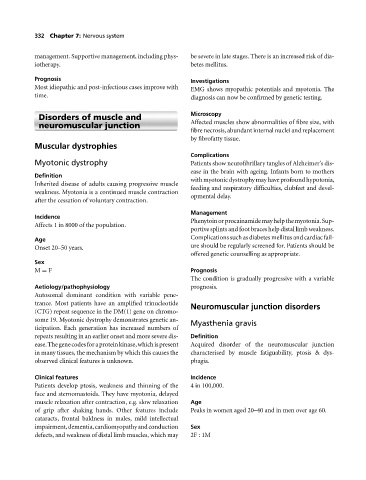Page 336 - Medicine and Surgery
P. 336
P1: FAW
BLUK007-07 BLUK007-Kendall May 25, 2005 18:18 Char Count= 0
332 Chapter 7: Nervous system
management. Supportive management, including phys- be severe in late stages. There is an increased risk of dia-
iotherapy. betes mellitus.
Prognosis Investigations
Most idiopathic and post-infectious cases improve with EMG shows myopathic potentials and myotonia. The
time. diagnosis can now be confirmed by genetic testing.
Disorders of muscle and Microscopy
neuromuscular junction Affected muscles show abnormalities of fibre size, with
fibre necrosis, abundant internal nuclei and replacement
by fibrofatty tissue.
Muscular dystrophies
Complications
Myotonic dystrophy Patients show neurofibrillary tangles of Alzheimer’s dis-
ease in the brain with ageing. Infants born to mothers
Definition
withmyotonicdystrophymayhaveprofoundhypotonia,
Inherited disease of adults causing progressive muscle
feeding and respiratory difficulties, clubfeet and devel-
weakness. Myotonia is a continued muscle contraction
opmental delay.
after the cessation of voluntary contraction.
Management
Incidence
Phenytoinorprocainamidemayhelpthemyotonia.Sup-
Affects 1 in 8000 of the population.
portive splints and foot braces help distal limb weakness.
Age Complications such as diabetes mellitus and cardiac fail-
Onset 20–50 years. ure should be regularly screened for. Patients should be
offered genetic counselling as appropriate.
Sex
M = F Prognosis
The condition is gradually progressive with a variable
Aetiology/pathophysiology prognosis.
Autosomal dominant condition with variable pene-
trance. Most patients have an amplified trinucleotide Neuromuscular junction disorders
(CTG) repeat sequence in the DM(1) gene on chromo-
some 19. Myotonic dystrophy demonstrates genetic an- Myasthenia gravis
ticipation. Each generation has increased numbers of
repeats resulting in an earlier onset and more severe dis- Definition
ease.Thegenecodesforaproteinkinase,whichispresent Acquired disorder of the neuromuscular junction
in many tissues, the mechanism by which this causes the characterised by muscle fatiguability, ptosis & dys-
observed clinical features is unknown. phagia.
Clinical features Incidence
Patients develop ptosis, weakness and thinning of the 4in 100,000.
face and sternomastoids. They have myotonia, delayed
muscle relaxation after contraction, e.g. slow relaxation Age
of grip after shaking hands. Other features include Peaks in women aged 20–40 and in men over age 60.
cataracts, frontal baldness in males, mild intellectual
impairment,dementia,cardiomyopathyandconduction Sex
defects, and weakness of distal limb muscles, which may 2F:1M

